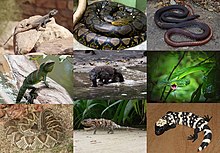
Back Skubreptiel Afrikaans Squamata AN حرشفيات Arabic حرشفيات ARZ Squamata AST Pulcuqlular Azerbaijani پولجوقلولار AZB Лускаватыя Byelorussian Лускаватыя BE-X-OLD Люспести Bulgarian
| Squamata | |
|---|---|

| |
| Scientific classification | |
| Domain: | Eukaryota |
| Kingdom: | Animalia |
| Phylum: | Chordata |
| Class: | Reptilia |
| Superorder: | Lepidosauria |
| Order: | Squamata Oppel, 1811 |
| Subgroups[1] | |
Squamata ("scaled reptiles") is the order of reptiles which includes lizards and snakes, and the Amphisbaenia.
Their skins have overlapping horny scales. They also have movable quadrate bones, which make it possible to move the upper jaw relative to the braincase. This is particularly visible in snakes, which are able to open their mouths very wide to accommodate comparatively large prey.
They are the most variably-sized order of reptiles, ranging from the 16 mm (0.63 in.) Dwarf gecko (Sphaerodactylus ariasae) to the 8 m (26 ft.) Green Anaconda (Eunectes murinus).
This is the only living reptile group which has both viviparous and ovoviviparous species, as well as the usual oviparous (egg-laying) reptiles.
The Squamata does not include the Tuataras from New Zealand. They are a sister group to the squamates. The Crocodilia are much more distantly related.
- ↑ Wiens, J. J.; Hutter, C. R.; Mulcahy, D. G.; Noonan, B. P.; Townsend, T. M.; Sites, J. W.; Reeder, T. W. (2012). "Resolving the phylogeny of lizards and snakes (Squamata) with extensive sampling of genes and species". Biology Letters. 8 (6): 1043–1046. doi:10.1098/rsbl.2012.0703. PMC 3497141. PMID 22993238.